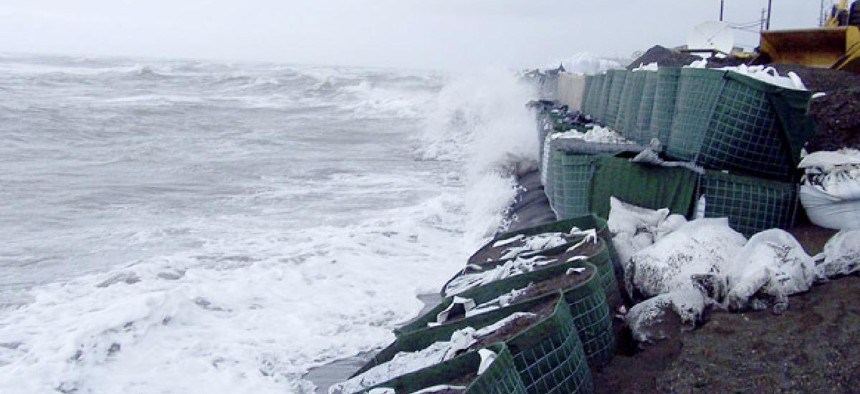First major climate regs from Obama EPA sure to stir political debate
Long-awaited global-warming regulations could arrive Tuesday.
The Obama administration is expected to unveil long-awaited global-warming regulations as soon as Tuesday in a move that will make a big splash politically but won’t have real environmental or economic impact until long after the 2012 elections.
The controversial rules -- initially setting limits on greenhouse-gas emissions from new power plants -- have been in the works since 2009, when the Environmental Protection Agency determined within a year of President Obama taking office that it had a legal obligation under the Clean Air Act to rein in carbon pollution that scientists say is one of the chief causes of climate change.
The planned regulations have been a top political target for just as long: Republicans and the fossil-fuel industry have attacked the proposed controls as a poster child for government overreach, saying they will kill jobs and send electricity prices soaring.
Coming in the midst of an election cycle in which energy prices, the EPA, and government regulation are all hot-button issues, the rollout of climate-change rules is likely to ignite a fresh line of political attacks, with GOP campaigns blasting Democrats and the president for hurting the economy and congressional Republicans introducing a slew of bills to block or delay the rules. (House Majority Leader Eric Cantor, R-Va., long ago put them on a list of “Top 10 job-killing regulations” that the Republican-led chamber would push hard to roll back.)
On the other side, the Obama reelection campaign hopes that issuing the climate-change rules will help ease frustrations among its liberal environmental base; many environmental groups have been less than enthusiastic in their support for Obama since last summer, when he delayed another major EPA clean air rule regulating smog. And while Obama regained their support after rejecting the controversial Keystone XL pipeline, some green groups remained tepid after Obama signaled that he may eventually approve the pipeline in a second term.
“Environmental groups will react very positively to this,” said Frank O’Donnell, president of the advocacy group Clean Air Watch. “Old King Coal may not be dead, but he could be on life support.”
On Monday, several environmental groups met with White House officials to discuss a campaign aimed at supporting the new rules once they’re rolled out.
But while the climate-change rules could fire up both Obama’s red-state foes and his green-group friends, it appears that neither side will have much to point to in terms of substance -- at least for many years.
That’s because the EPA has deftly crafted the rollout to score political points now but delay the environmental and economic impacts until later.
According to sources familiar with the rules, the first proposal will only require new coal- and gas-fired power plants to limit emissions of carbon pollution. Rules to control carbon from existing plants won’t come until later, possibly after the November elections.
As a result, the first power plant forced to comply with the rules probably won’t even be built for years. There are currently about a dozen proposed power plants going through the licensing and permitting process; these will be grandfathered in and not subject to the new rules, either, said sources who asked to remain anonymous because the rules have not been released.
Rolling out the rules this way allows Obama to revitalize his base by standing firm on his commitment to tackle climate change, and it defangs his opposition since the rules will require no existing plants to install expensive new technology or close down.
Going forward, the rules are expected to allow new power plants significant flexibility in how they comply with the rules: for the first 10 years of operation, a new power plant may operate without carbon constraints. But over 30 years, coal and gas plant operators must show that over the three decades, the plant produced no more than an average of 1,000 pounds of carbon dioxide per megawatt-hour: that’s about the same amount of carbon pollution currently produced by natural gas plants, and about half the amount of pollution currently produced by coal plants.
While the rules won’t cut U.S. greenhouse-gas emissions significantly in the next few years, over the course of the next few decades they are likely to drive power companies away from building heavily polluting coal plants and towards building cleaner, lower-polluting natural gas plants. As it happens, many power companies are already making that choice -- thanks to market forces, rather than regulations. A recent glut of domestic natural gas production has sent the price of natural gas plummeting, so power plant operators say that the new climate-change rules happen to conform to many companies’ existing long-term investment plans.
Even one of the nation’s most coal-reliant utilities, Ohio-based American Electric Power -- which has come out in fierce opposition to many other Obama EPA rules -- says climate-change rules for new plants probably won’t hurt the company’s bottom line.
“We don’t have any plans to build new coal plants. So the rules won’t have much of an impact,” said Melissa McHenry, a spokeswoman for the company. “Any additional generational plants we’d build for the next generation will be natural gas. It will shape sources for new generation. But in the near term, the impact will not be as great. It impacts the ability to expand the use of coal for electricity, but it doesn’t cause immediate concern for us.”
But while environmental groups understand Obama’s political motivation for taking a baby step toward addressing climate change, they will also hold his feet to the fire to do the tougher work of clamping down on existing power plant pollution if he is reelected.
“It’s not acceptable to us that they would put out only a new-source rule,” said Conrad Schneider, advocacy director of the nonprofit group Clean Air Task Force. “We believe that together, new and existing standards are the most important energy and climate decision they will make.”







